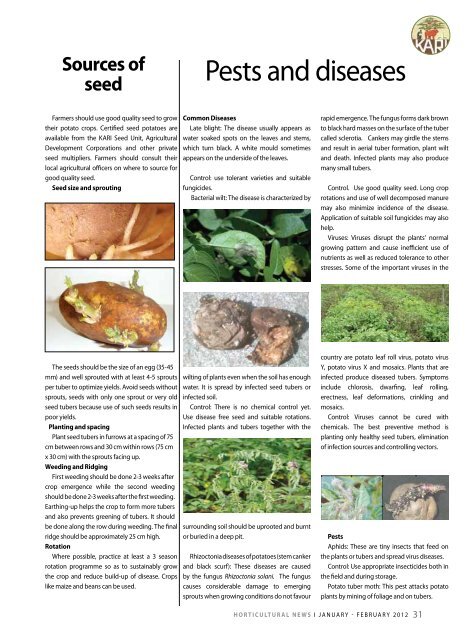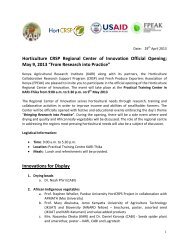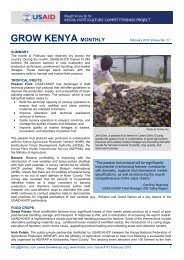Horticultural News January - February issue
Horticultural News January - February issue
Horticultural News January - February issue
Create successful ePaper yourself
Turn your PDF publications into a flip-book with our unique Google optimized e-Paper software.
Sources of<br />
seed<br />
Farmers should use good quality seed to grow<br />
their potato crops. Certified seed potatoes are<br />
available from the KarI Seed unit, agricultural<br />
Development Corporations and other private<br />
seed multipliers. Farmers should consult their<br />
local agricultural officers on where to source for<br />
good quality seed.<br />
Seed size and sprouting<br />
The seeds should be the size of an egg (35-45<br />
mm) and well sprouted with at least 4-5 sprouts<br />
per tuber to optimize yields. avoid seeds without<br />
sprouts, seeds with only one sprout or very old<br />
seed tubers because use of such seeds results in<br />
poor yields.<br />
Planting and spacing<br />
Plant seed tubers in furrows at a spacing of 75<br />
cm between rows and 30 cm within rows (75 cm<br />
x 30 cm) with the sprouts facing up.<br />
Weeding and Ridging<br />
First weeding should be done 2-3 weeks after<br />
crop emergence while the second weeding<br />
should be done 2-3 weeks after the first weeding.<br />
Earthing-up helps the crop to form more tubers<br />
and also prevents greening of tubers. It should<br />
be done along the row during weeding. The final<br />
ridge should be approximately 25 cm high.<br />
Rotation<br />
Where possible, practice at least a 3 season<br />
rotation programme so as to sustainably grow<br />
the crop and reduce build-up of disease. Crops<br />
like maize and beans can be used.<br />
Pests and diseases<br />
!<br />
Common Diseases<br />
Late blight: The disease usually appears as<br />
water soaked spots on the leaves and stems,<br />
which turn black. a white mould sometimes<br />
appears on the underside of the leaves.<br />
Control: use tolerant varieties and suitable<br />
fungicides.<br />
Bacterial wilt: The disease is characterized by<br />
wilting of plants even when the soil has enough<br />
water. It is spread by infected seed tubers or<br />
infected soil.<br />
Control: There is no chemical control yet.<br />
use disease free seed and suitable rotations.<br />
Infected plants and tubers together with the<br />
surrounding soil should be uprooted and burnt<br />
or buried in a deep pit.<br />
rhizoctonia diseases of potatoes (stem canker<br />
and black scurf): These diseases are caused<br />
by the fungus Rhizoctonia solani. The fungus<br />
causes considerable damage to emerging<br />
sprouts when growing conditions do not favour<br />
rapid emergence. The fungus forms dark brown<br />
to black hard masses on the surface of the tuber<br />
called sclerotia. Cankers may girdle the stems<br />
and result in aerial tuber formation, plant wilt<br />
and death. Infected plants may also produce<br />
many small tubers.<br />
Control. use good quality seed. Long crop<br />
rotations and use of well decomposed manure<br />
may also minimize incidence of the disease.<br />
application of suitable soil fungicides may also<br />
help.<br />
Viruses: Viruses disrupt the plants’ normal<br />
growing pattern and cause inefficient use of<br />
nutrients as well as reduced tolerance to other<br />
stresses. Some of the important viruses in the<br />
country are potato leaf roll virus, potato virus<br />
y, potato virus X and mosaics. Plants that are<br />
infected produce diseased tubers. Symptoms<br />
include chlorosis, dwarfing, leaf rolling,<br />
erectness, leaf deformations, crinkling and<br />
mosaics.<br />
Control: Viruses cannot be cured with<br />
chemicals. The best preventive method is<br />
planting only healthy seed tubers, elimination<br />
of infection sources and controlling vectors.<br />
Pests<br />
aphids: These are tiny insects that feed on<br />
the plants or tubers and spread virus diseases.<br />
Control: use appropriate insecticides both in<br />
the field and during storage.<br />
Potato tuber moth: This pest attacks potato<br />
plants by mining of foliage and on tubers.<br />
H O R T I C U LT U R A L N E W S I j a n u a r y - F E B r u a r y 2 0 1 2 31












